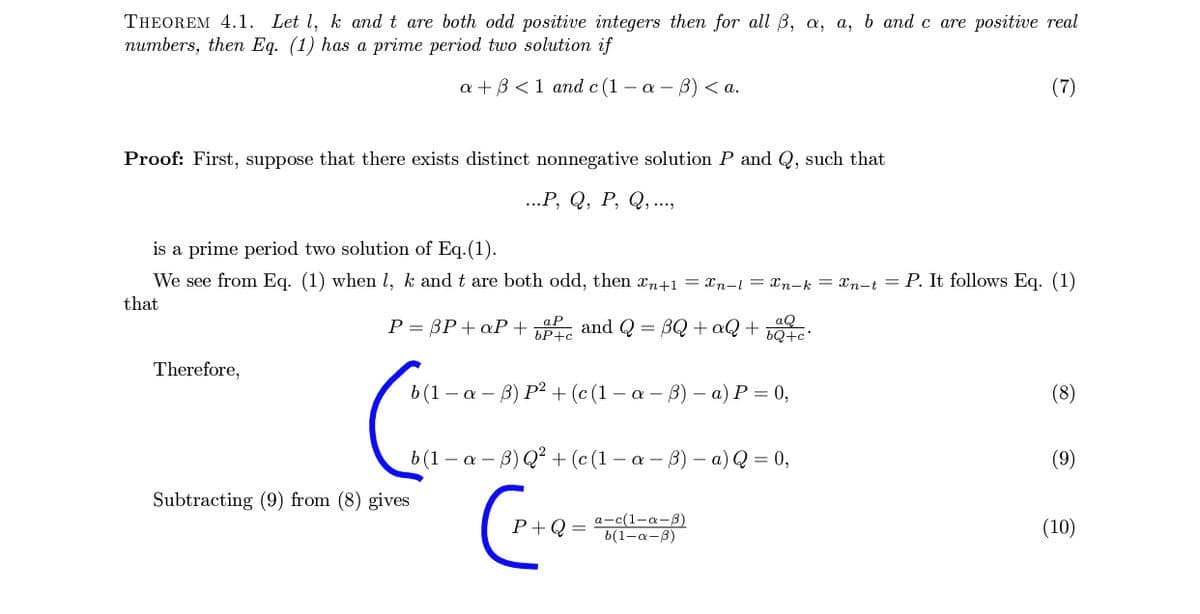THEOREM 4.1. Let l, k and t are both odd positive integers then for all B, a, a, b and c are positive real numbers, then Eq. (1) has a prime period two solution if a +B <1 and c(1- a - 3) < a. (7) Proof: First, suppose that there exists distinct nonnegative solution P and Q, such that ...Р, Q, Р, Q, .., is a prime period two solution of Eq.(1). We see from Eq. (1) when l, k and t are both odd, then xn+1 = xn=1 = Xn-k = xn-t = P. It follows Eq. (1) that P = BP+ aP + , and Q = BQ +aQ + Therefore, b (1— а - B) Р? + (с (1 —а - 3) — а) Р %3D0, (8) b(1 - a - B) Q + (c (1 - a - 3) - a) Q = 0, (9) Subtracting (9) from (8) gives P+Q= a-c(1-a-8) b(1-a-8) (10)
THEOREM 4.1. Let l, k and t are both odd positive integers then for all B, a, a, b and c are positive real numbers, then Eq. (1) has a prime period two solution if a +B <1 and c(1- a - 3) < a. (7) Proof: First, suppose that there exists distinct nonnegative solution P and Q, such that ...Р, Q, Р, Q, .., is a prime period two solution of Eq.(1). We see from Eq. (1) when l, k and t are both odd, then xn+1 = xn=1 = Xn-k = xn-t = P. It follows Eq. (1) that P = BP+ aP + , and Q = BQ +aQ + Therefore, b (1— а - B) Р? + (с (1 —а - 3) — а) Р %3D0, (8) b(1 - a - B) Q + (c (1 - a - 3) - a) Q = 0, (9) Subtracting (9) from (8) gives P+Q= a-c(1-a-8) b(1-a-8) (10)
Linear Algebra: A Modern Introduction
4th Edition
ISBN:9781285463247
Author:David Poole
Publisher:David Poole
Chapter6: Vector Spaces
Section6.2: Linear Independence, Basis, And Dimension
Problem 61EQ
Related questions
Question
Show me the steps of determine blue and information is here

Transcribed Image Text:Our goal is to obtain some qualitative behavior of the positive solutions of the difference equation
Xn+1 = Bxn-i+axn-k +
axn-t
n = 0, 1, ...,
(1)
bxn-t+c'
where the parameters 3, a, a, b and c are positive real numbers and the initial conditions x-s, x-s+1, ..., x-1,
xo are positive real numbers where s = max{1, k, t}.
.D TT T T

Transcribed Image Text:THEOREM 4.1. Let l, k and t are both odd positive integers then for all B, a, a, b and c are positive real
numbers, then Eq. (1) has a prime period two solution if
a+B <1 аnd c (1 — a — в) < а.
(7)
Proof: First, suppose that there exists distinct nonnegative solution P and Q, such that
...Р, Q, Р, Q, ...,
is a prime period two solution of Eq.(1).
We see from Eq. (1) when l, k and t are both odd, then xn+1 = xn-1 = xn-k = Xn-t = P. It follows Eq. (1)
that
aQ
P = BP + aP+ , and Q = BQ + aQ+ O
.+09
bP+c
Therefore,
b(1 — а — В) Р2 + (с (1 — а — В) — а) Р — 0,
(8)
b (1 — а —
В) Q + (с (1 — а - B) — а) Q — 0,
(9)
Subtracting (9) from (8) gives
+Q = "
a-c(1-a-8)
b(1-a-B)
(10)
Expert Solution
This question has been solved!
Explore an expertly crafted, step-by-step solution for a thorough understanding of key concepts.
Step by step
Solved in 2 steps with 2 images

Recommended textbooks for you

Linear Algebra: A Modern Introduction
Algebra
ISBN:
9781285463247
Author:
David Poole
Publisher:
Cengage Learning

Algebra & Trigonometry with Analytic Geometry
Algebra
ISBN:
9781133382119
Author:
Swokowski
Publisher:
Cengage

Elements Of Modern Algebra
Algebra
ISBN:
9781285463230
Author:
Gilbert, Linda, Jimmie
Publisher:
Cengage Learning,

Linear Algebra: A Modern Introduction
Algebra
ISBN:
9781285463247
Author:
David Poole
Publisher:
Cengage Learning

Algebra & Trigonometry with Analytic Geometry
Algebra
ISBN:
9781133382119
Author:
Swokowski
Publisher:
Cengage

Elements Of Modern Algebra
Algebra
ISBN:
9781285463230
Author:
Gilbert, Linda, Jimmie
Publisher:
Cengage Learning,